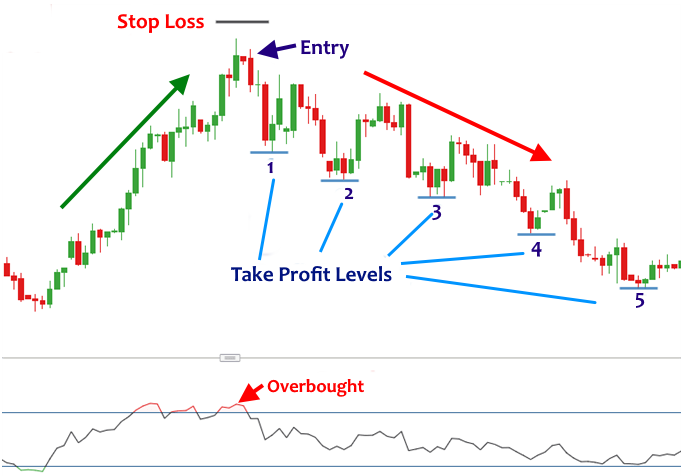The Bearish Harami is a two-candlestick pattern, steeped in the ancient wisdom of Japanese candlestick charting, and is a potent signal for a potential market reversal. This article will delve into the depths of the Bearish Harami pattern, its characteristics, how to identify it on trading charts, and how it influences trading decisions.
What is a Bearish Harami?
The Bearish Harami pattern is a candlestick formation that suggests a possible bearish reversal in the market. The name “Harami” derives from the Japanese word for “pregnant,” which aptly describes the pattern’s visual representation.
Structure of the Bearish Harami
The Bearish Harami pattern comprises two candlesticks:
- The first is a bullish candle with a large body, signifying a strong upward movement.
- The second is a bearish candle, smaller in size, and completely enclosed within the body of the first candle.
This arrangement creates an image reminiscent of a pregnant woman, hence the name. The large bullish candle represents the ‘mother’, while the small bearish candle symbolizes the ‘baby’.
The Bearish Harami pattern emerges at the peak of an uptrend, signaling a potential reversal. In other words, it’s a warning sign that the bulls are losing their grip, and the bears may soon take control.
Identifying a Bearish Harami on Trading Charts
To spot a Bearish Harami on trading charts, traders need to follow a few steps:
- Identify an existing uptrend: The Bearish Harami appears at the top of an uptrend, so the first step is to pinpoint a rising market.
- Look for signals of slowing/reversing momentum: This could involve stochastic oscillators, bearish moving average crossover, or other bearish candle formations that suggest a shift in market momentum.
- Check the size of the bearish candle: The body of the small bearish (red) candle should not exceed 25% of the previous bullish (green) candle.
- Observe the candle positioning: The entire bearish candle should be enclosed within the body of the preceding bullish candle.
In addition to these steps, traders should also consider supporting indicators and key resistance levels to reinforce their trading decisions.
Formation of the Bearish Harami Pattern in Different Markets
The appearance of the Bearish Harami can vary slightly between the forex and stock markets due to the differing operational characteristics of these trading arenas.
Forex Market
In the forex market, which operates 24/5, one candlestick immediately follows the closing of another. Under typical market conditions, the Bearish Harami pattern in forex appears as a small bearish candle that opens at or close to the level where the previous bullish candle closed.
Stock Market
The stock market, with defined trading hours, often sees gaps in the open due to various factors such as company news, sector data, regulatory changes, or general market sentiment. In this context, the Bearish Harami pattern often presents as a bearish candle that gaps down, appearing midway down the previous bullish candle.
Trading the Bearish Harami Candlestick Pattern
Trading the Bearish Harami pattern requires a systematic approach.
- Identify a clear uptrend: The presence of an upward trend is critical for a Bearish Harami to form.
- Look for overbought indications: Tools like the Relative Strength Index (RSI) can help identify overbought scenarios, potentially signaling waning upward momentum.
- Assess the bearish candle: It should be no more than 25% the size of the preceding bullish candle.
- Check the opening and closing of the bearish candle: Both should fall within the range of the prior bullish candle.
- Consider the location of the Bearish Harami: If it appears at a new high, it could signal that the market has turned lower.
Traders can set stop-loss orders above the new high and enter the market at the opening of the candle following the completion of the Bearish Harami pattern.
The Reliability of the Bearish Harami
While the Bearish Harami is a useful signal, its reliability depends on numerous factors.
Advantages of the Bearish Harami:
- Potential early entry points: The Bearish Harami often appears at the start of a potential downtrend, enabling traders to enter the market early.
- Ease of identification: Even novice traders can easily spot this pattern.
- Attractive risk-reward ratio: Compared to other patterns like the Bearish Engulfing pattern, the Bearish Harami often presents a more favorable risk-reward ratio.
Limitations of the Bearish Harami:
- Not standalone: The Bearish Harami should not be traded solely based on its formation. It must be used in conjunction with other technical analysis tools or indicators.
- Dependent on trend position: The Bearish Harami must appear at the top of an uptrend for it to be valid.
The Psychology Behind the Harami Pattern
Bearish Harami
The Bearish Harami pattern begins with a strong uptrend, resulting in a large bullish candle on the first day. The second day sees prices opening with a gap down, suggesting that the bears are seizing control and exerting selling pressure. However, the bearish candle of the second day does not fall below the opening price of the first day’s candle.
Confirmation for Bearish Harami
Similarly, for the Bearish Harami, the confirmation comes with the third candle. If the third candle is bearish and crosses the low of the first candle, it confirms the pattern.
Final Thoughts
The Bearish Harami is a valuable tool in a trader’s toolkit, offering significant insights into potential market reversals. However, it should not be used in isolation. Traders should combine it with other technical analysis tools, indicators, and a comprehensive understanding of the larger market environment to make informed trading decisions.
Remember, in the world of trading, knowledge, strategy, and patience often make the difference between success and failure!
Hurry! Grab special offers with MyFundedFx. Manage Simulated Capital Up to $600k with profits of up to 80%.
- 8 Best Prop Firms USA: Real trader Reviews and Payouts - March 10, 2025
- Forex Trading in Uganda: Start With $10—An Incredible Opportunity on a Tight Budget! - February 24, 2025
- Master Forex Trading Algorithms: Your Path to Success in 2025 - February 17, 2025







